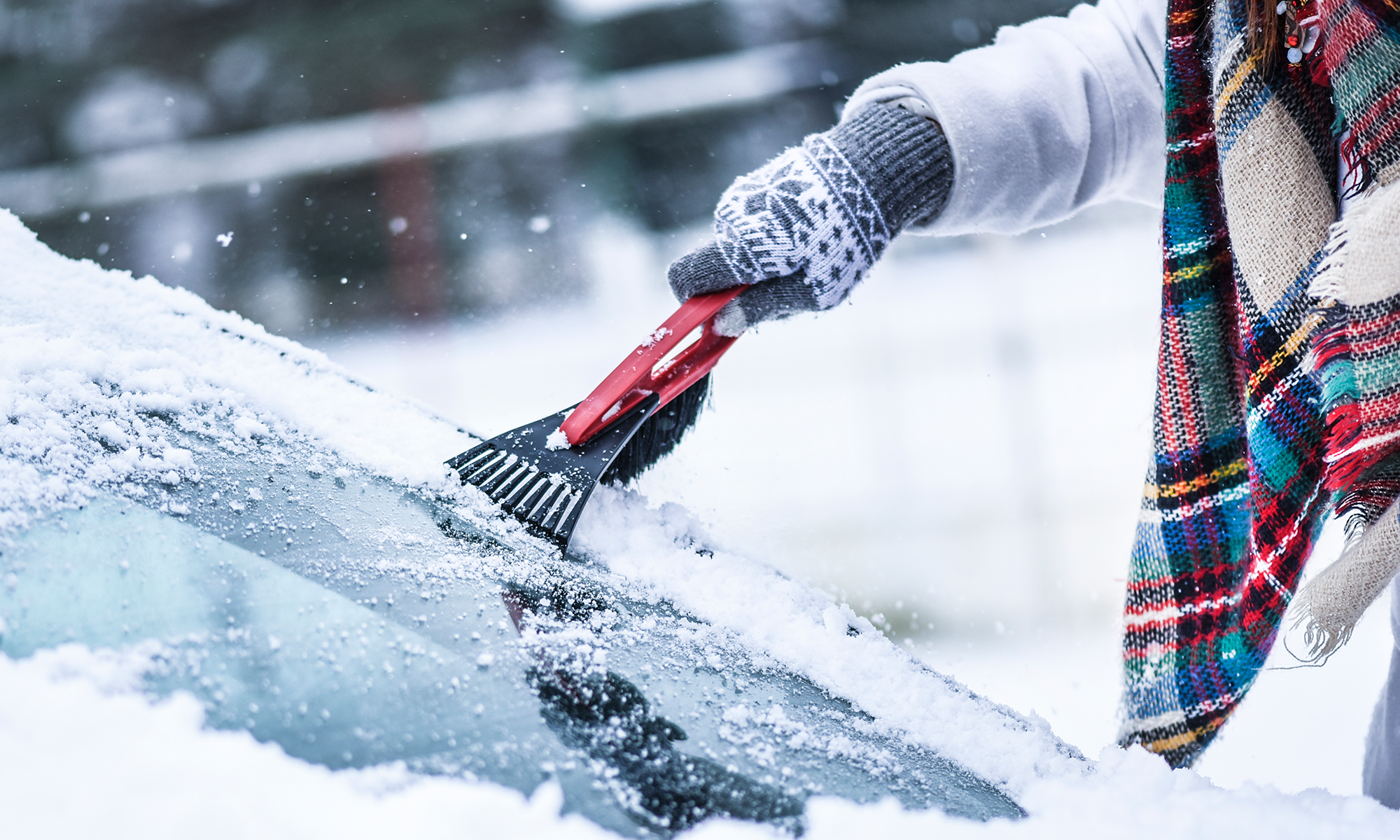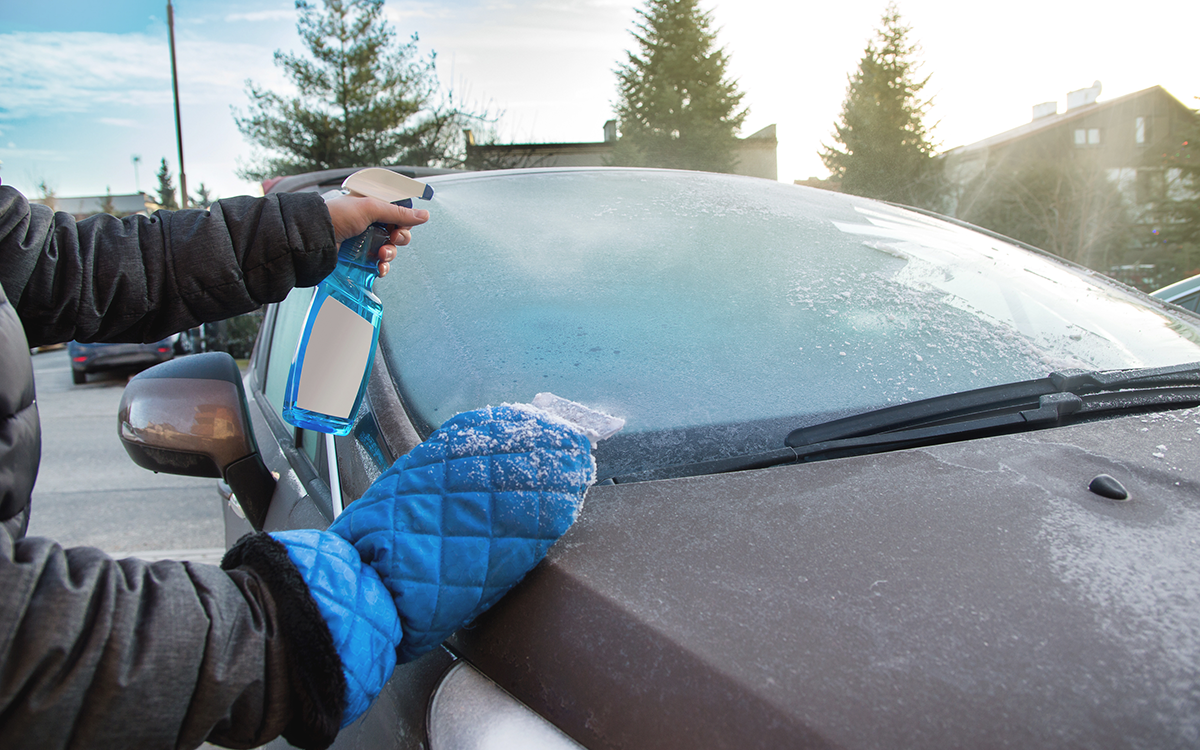How to De-Ice Your Windshield

With Christmas just 10 days away, you’re likely gearing up and getting ready for the holiday. Along with any last-minute gift shopping, however, it’s also the perfect time to ensure your car is ready for the holiday. After all, if you’re a driver in the northeast, the Pacific-northwest or everywhere in between, nothing makes holiday travel worse than an ill-timed snowstorm. Even if the forecast is clear, the freezing temperatures can bring about a real yet often overlooked winter safety issue: an icy or foggy car windshield.
Foggy and icy windshields are far from being just a nuisance, as they can make driving extremely dangerous. Thankfully, there are plenty of ways you can safely de-ice and even avoid ice and fog build-up on your car windows.
Today we’ll take a look at some of the most effective.
Why Do Car Windshields Get Icy?
Car windshields can become icy inside or out (or both) because of temperature and moisture. When the weather conditions are right, frost can develop, but where that frost forms will depend on the surface’s temperature and humidity level.
Certain materials cool down much faster than others, making them more susceptible to frost. Glass and metal are two such materials. Because they disperse heat faster than others, they may reach a freezing point even when the air temperature isn’t as cold.
Like ice, foggy windows and windshields are also due to moisture and temperature. On a cold day, any moisture inside your vehicle (from passengers exhaling, rain or snow on your clothes, etc.) will turn into condensation when it hits the air next to the windows. It’s this condensation that causes your windows to fog up. Even on a hot, humid day, the same can happen when your air conditioning system brings moist air near the windows down to the right temperature.
How to De-Ice Your Windshield

There doesn’t need to be a fresh snowfall to deal with an icy windshield. Luckily, there are a few ways you can quickly and safely de-ice your car’s windshield to get you on the road:
- Let your car warm up: the easiest way to de-ice any car windshield is by using your car’s defrost feature. Be warned, however, as this isn’t always the fastest solution and letting your car idle isn’t always recommended, especially with older vehicles. Instead, once you have a clear line of sight out of your windshield and windows, start driving, as this will help the vehicle warm up faster than just letting it sit.
- Use a de-icer: whether it’s store-bought or a homemade de-icer spray, a de-icing solution is a great way to clear your windshield. If you are going the DIY route, use two parts isopropyl alcohol (aka rubbing alcohol) to one part water and some dish soap. Just be sure to use a clean spray bottle and never use boiling or hot water when using a DIY de-icer, as the sudden temperature change can end up causing your car’s windshield or windows to crack or potentially even shatter due to “thermal shock.”
- Try a saltwater solution: it may seem counter-intuitive to use water to de-ice something, but combine it with simple table salt, and you’ve got a quick de-icer hack. This is because saltwater has a lower freezing point than regular H2O, helping to clear up any ice. Only use a saltwater solution on your car’s windows, as it and the general road salt used this season can lead to rust and other issues on model components or body panels.
- Use an ice scraper: when in doubt, using a little elbow grease and an ice scrapper can help clear up your windshield and windows.
De-icing your car’s windshield is the best way to help give you a clear line of sight while driving during the wintertime. But while this is great to help you stay safe while driving, it can’t help you when facing an unexpected automotive repair bill. Luckily, with an Endurance auto protection plan, you can get peace of mind for your car’s vital components year-round. Plus, as an Endurance customer, you’ll have perks like complimentary roadside assistance and a full year of Endurance Elite Benefits, including collision discounts, total loss protection and more. Not to mention, you’ll be able to get help from an award-winning Endurance specialist and access to the exclusive Endurance Mobile app so you can access your contract right from the palm of your hand.
How to Prevent Icy Windshields in Winter
Icy windshields are a nuisance, and having some quick tips to get rid of them is always helpful. But what’s better than not having to de-ice them, especially if you don’t have a garage to park in? Here are a few ways to prevent an icy windshield any winter:
1. Invest in a Windshield Cover (Or Make Your Own)
A Windshield cover, whether anchored to your wing mirrors or held in place by your doors, acts as a barrier against moisture, preventing frost, fog, and frozen wiper blades. Even better, you can continue to use your windshield cover in the summer to keep your vehicle cool and protect interiors from sun damage. Nothing is more annoying than waking up to find your windshield wipers frozen stiff; a windshield cover is the best way to prevent this from happening. You can even use a plastic bag to cover the wing mirrors—anything is better than nothing.
If you don’t have time to run to the store to buy a windshield cover but know it’s going to be cold overnight, making your own cover can be a great quick fix. Get creative with a towel, a piece of carpet, or even a shower curtain. They might not be as good, but they can help in a pinch.
2. Apply De-icer Every Night
De-icers and saltwater solutions aren’t just great at removing ice from your windshield; they help prevent it too. Spray on before you head inside the house, and you’ll wake up to car windows free of ice. Just remember that, whatever you do, don’t use warm water, as a sudden change in temperature can cause severe damage to auto glass.
3. Park in the Right Place
If ice is your enemy, then the sun is your friend. By making sure you park facing east (the direction the sun rises in), any windshield ice should have melted naturally by the time you set out in the morning.
How to Prevent Foggy Windshields in Winter
Unless you accidentally forget to close a window, you’ll likely never deal with a frozen windshield inside your vehicle. Instead, you’ll be faced with another nuisance, a foggy windshield. Like an icy windshield, however, there are several ways you can prevent a foggy windshield:
1. Put Something Absorbent in Your Vehicle
Placing something absorbent in your vehicle overnight will reduce the amount of moisture in the air and prevent fog. Silica gel packs, chalk sticks, and even a cloth bag filled with cat litter are all good options, or you could go all out and purchase a disposable dehumidifier.
2. Air It Out after a Drive
Taking a moment to open the windows and let the air circulate after being in your car can help you potentially avoid a foggy windshield the next time you get in the driver’s seat. Just remember to close them again before you head inside.
3. Switch On the A/C
If you’re an experienced driver, chances are you know this go-to method when dealing with fog. For newer drivers, using your car’s A/C (or even that trusted defroster setting) can help you clear up any fog in minutes (it’ll help you warm up, too). A blast of warm, dry air will reduce moisture and hopefully clear things up. Just make sure to have the recirculation function turned off so that you aren’t bringing more moisture in from the outside.
4. Keep Your Windows Clean
Dirt on the interior side of your windows gives moisture something to cling to, and if we’ve learned anything by now, it’s that moisture on windows equals fog. Not only will a dirty window make fog more likely, but it will also make the fog a dirty color, which is even harder to see through. Once you’re done cleaning, dry off the windows before leaving the car.
5. Leave Plenty of Time Before You Leave
This may not exactly be a preventative tip, but an important one nonetheless. Whether it’s fog or ice, don’t leave it until the last minute to defog and defrost your vehicle. Not only is it stressful to deal with, but rushing out with low visibility can be hazardous for you and others.
Get Peace of Mind This Winter with Endurance
De-icing your car’s windshield and windows can help ensure you have a safe line of sight when driving. But, while de-icing your windshield or preparing your vehicle for winter weather, in general, is always recommended, neither can prevent the unexpected. And when it comes to unexpected (and expensive) repair bills, only Endurance can give you peace of mind any time of the year.
With an award-winning auto protection plan from Endurance, you can get comprehensive breakdown coverage for your car’s vital components, including the engine, transmission and more. Better still, whether you’re looking for basic powertrain coverage as low as $79 a month or near factory-like coverage, Endurance has a plan for you. Even owners of vehicles that other providers often exclude, including select luxury vehicles, high-mileage vehicles, salvage or rebuilt title vehicles, Canadian Grey Market vehicles, and more, can get coverage with Endurance. You’ll also get complimentary roadside assistance, trip interruption coverage, rental car reimbursement, and a full year of Endurance Elite Benefits for even more perks and savings.
Call our award-winning customer service team at (800) 253-8203 to request a FREE quote, or shop online today to learn more about how an Endurance protection plan can help you. You can also find other helpful DIY maintenance tips and tricks, as well as other articles on topics ranging from expert auto advice to vehicle buying guides, extended warranty coverage comparisons and more, by visiting the Endurance blog.













As both an Army Veteran & ASE Certified repair shop owner, Andrew has made educating the modern driver an ongoing mission since the opening of his repair shop, Midwest City Autospa, in 2012. Read more about Andrew.